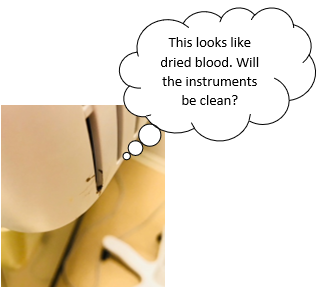Posted by Kristin Baird
In today’s world of digital communication, consumers share everything from photos of their food to gross videos of bodily functions. Snapshots and videos from medical facilities are among the frequently posted images online. Unfortunately, the medical facility leaders are either the last to know or kept in the dark while consumers share their stories and photo documentation of their visits.
Today as I was working in my Wisconsin office, I heard my phone beep repeatedly notifying me texts had arrived. Upon opening my phone, I found myself looking at, what I quickly identified as a filthy exam room. A colleague took and shared the photos in real time. Her photos showed dried blood on one of the surfaces, dirt, dust and hair collected around the base of the exam table, chairs and lamp. She expressed that she was appalled at the condition of the room. They were freezing while they waited in a room with no music or other soothing amenities.
She later told me, “Having a pap test is uncomfortable enough, but everything about the office staff’s abrupt demeanor combined with the condition of the room was really off-putting. If I didn’t love my doctor, I would have left long ago.” When I asked her if she planned to write or call with her concerns she said, “No. I don’t want to put the energy into it.” This is a key point. Here is a well-educated, savvy consumer who didn’t plan to take action with the clinic. Yet she had just shared her story AND photos with me. How many more times will she share this story and photos?
Believe me when I say that this type of communication is happening all day, every day, from all over the country. People snap photos, and post comments about medical encounters on social media. Providers are the last to know – if they find out at all.
Medical Mystery Shopping
This is exactly why healthcare organizations should be doing medical mystery shopping. Instead of finding out about their patients’ horror stories on social media, proactive organizations can capture the most imminent opportunities for improvement through the mystery shopper’s documentation. The mystery shopper can give details about date, time and even the exam room number where the negative experience occurred. That way you can fix the problem before someone posts it for the world to see.
No one is perfect. But wouldn’t you want to know about the things that are eroding your patient trust right now? I would.
- Tweets = Rankings
- Trust is the Center of the Patient Experience
- What Drama is Unfolding in Your Waiting Room?
- Employees behaving badly? What you don’t know can hurt you!
- Going Viral from a Waiting Room Near You

